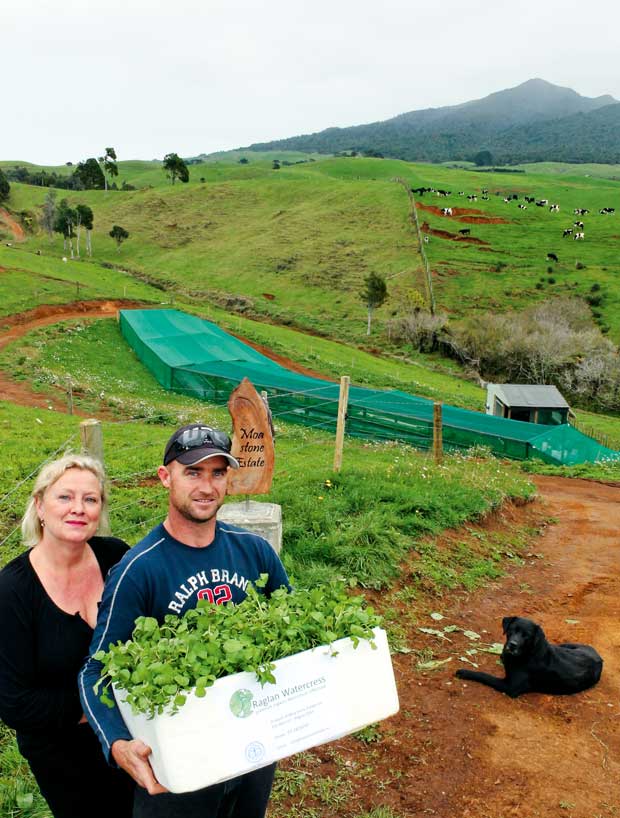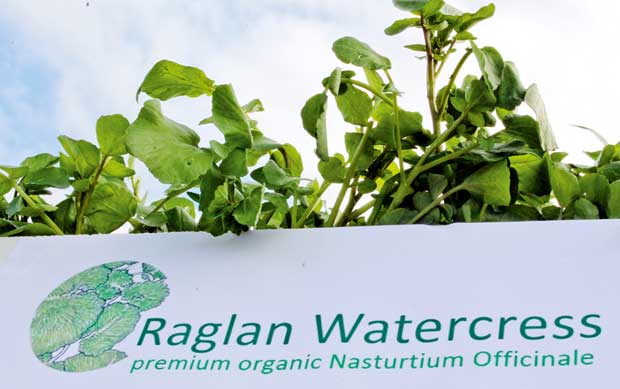Innovation driving success of Raglan watercress farm

Mika, Josh and Bully show off their watercress operation near Raglan.

A gravity driven watering system is just one of the innovations in use at an organic watercress farm in Raglan.
Words: Nadene Hall
Who: Mika in ‘t Veld, Josh Cornes & Bully the dog, Moa Stone Estate
Where: Raglan
What : organic watercress
Land: 0.4ha (1 acre)
The steep hills and clay soil on this small block might make most people think there’s nothing that could be grown for profit. But for Mika in ‘t Veld and Josh Cornes the best crop was obvious.
“We realised that we’re very fortunate here on the farm,” says Mika. “We have access to the purest water and we’ve got hill country that gives natural gravity, so we started working with these essentials. And the two of us have the combined skills to make this work.”
Josh has worked on farms for years, and Mika lived on a farm in the Netherlands while she developed eco-friendly ways of keeping birds away from fruit and vegetable crops, buildings and airports.
“About a decade ago Josh got inspired and decided he wanted to grow watercress, and from the moment he told me I jumped on board thinking that’s the oldest and most nutritious vegetable there is.”
Watercress grows as a weed in waterways around NZ but it can be a dangerous proposition to eat it when you don’t know the water quality as it can carry food-borne illnesses like giardia, liverfluke and E. coli.
Josh and Mika’s set-up takes delicious, clean, pure water from the farm’s deep well and runs it through purpose-built troughs, designed and built by Josh.
“We’re using that gravity, using that water, and Josh built it as a re-circulatory water system, so the water comes straight from the well, runs through the troughs using gravity, then we use solar to pump it back so we can re-use the water. We work with several pumps so it’s a continuous stream.”
The decision to go organic was officially made last year, but Mika says she and Josh had already inadvertently made many of the right choices in their set-up.
“It’s actually quite funny… in November [2014] we decided to take the plunge and go for it, but we didn’t realise that all our preparations, our choices of building materials, fertilisers, the seeds we’d been testing and selected, were possibly according to organic standards. We just followed our gut feeling and we made choices that were logical to us… it was probably early December, in one of our brainstorm sessions, that we realised we might actually be able to get an organic certificate.”

Growing watercress isn’t difficult, but setting up an efficient and easy-to-run system has involved a lot of careful engineering, one of Josh’s specialities.
“It’s just the logic, the whole design of the troughs, the amount of water that comes in, how many pumps, solar power and batteries do we need? How much water do we need to let it stream at the right current? What are we going to use to feed the plants? How much do we need? How do we test the water?”
What they came up with is four large troughs, each 20-25m long and about 2m wide. There are inlets and outlets at different heights.
“With the water inlet from the well, Josh created a natural effect like a creek going through, and we built a cover with a sprinkler system in the top so it adds a natural situation of rain.
“We’ve done everything you can possibly think of and decided that the best way for the seeds to grow is straight into the troughs, with us being able to raise and lower the water level at different points.”
The troughs sit just below dirt level so planting out and harvesting could have been a back-breaking exercise, but Josh is already thinking ahead. He grew up on this land – it’s part of the family farm – and he’s a dab hand with all kinds of machinery says Mika.
“He’s designing a harvesting machine that can run over the troughs and besides harvesting, it will give us easy access just rolling over the troughs and doing whatever is necessary.”
Their latest project is to fine-tune the growth of the plants. Mika has already thrown a few tricks in: seeds are initially put into the dark; after 24 hours they are placed in the light, giving the seeds a big ‘shock’; seedlings then usually emerge within a day and get to eating size within six weeks.
Watercress is a crop that tends to bolt into flower if grown over summer so the key growing periods are the cooler months of the year to keep the plants producing plenty of delicious, peppery leaves. Caring for the plants organically has been a big learning curve says Mika.
“We can’t spray the weeds, you can’t use chemicals to get rid of algae or to bring the pH up or down in the water. It’s actually during the last month that we’ve learned how to read the pH and nutrient level accurately.
“Also, we learned the seasons when the algae grow, and we are allowed to use natural materials, like a bit of copper wire we used to prevent algae growth.
“At one stage we had to use an organic vinegar to work on the pH a little bit. We now pretty much know how high or how low it needs to be coming in or going out of the trough.”
Further experiments will involve keeping the water temperature warmer over winter to see if they can stop the plants from going dormant, and then cooling it for summer conditions to try to stop plants bolting to flower. It’s a big challenge and time will tell, says Mika.
“We haven’t sold any produce yet. We mainly focused on the technology behind it all, the fertilisers, the re-circulatory system and getting certified organic even before we started selling.
“Both of us feel like we should really follow the idea of growing and selling local, that will be our first choice.”
Dealing with the certification process has been helped by the practical support they’ve had from Bio-Gro.
“Straight away from first contact we had we felt their support,” says Mika.
“Little tips, the friendly way of communication and by being able to use their website with all knowledge available.
“You’ve got to go through a lot of paperwork, but they really encourage you and help you in the right direction, like pointing out we are growing aquaculture, which eliminates booklets we don’t have to struggle through.”
The couple have even more ideas on what to do with their set-up once they start selling their organic watercress, like making new products with watercress.
“It’s an amazing journey: we learn, we innovate and we love it. Both our minds are all over the place and we are not limited to watercress. We just created natural wind breaks with feijoa plants and macadamia nut trees that can use the high quality waste water of the watercress.
“We just keep thinking ‘what grows in streaming water?’ so we’re building more troughs to have different plants, like water chestnut and wasabi, that’s the next challenge.”
Love this story? Subscribe now!
 This article first appeared in NZ Lifestyle Block Magazine.
This article first appeared in NZ Lifestyle Block Magazine.

